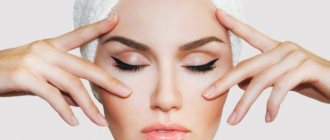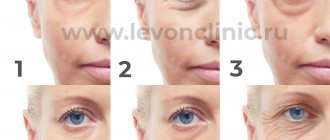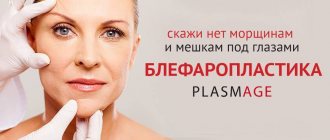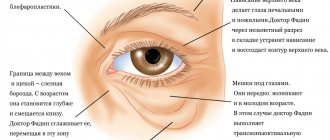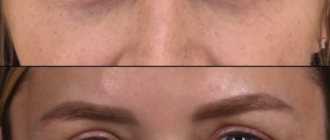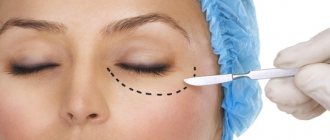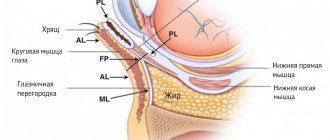Anesthesia or local anesthesia? When performing certain plastic surgeries, the patient can independently choose one of two proposed options. If you decide to have a traditional abdominoplasty, then anesthesia will definitely be chosen, even without your participation. But if you just want to have eyelid surgery, then here you can express your preferences regarding pain relief. Blepharoplasty is sometimes performed under local anesthesia, which pleases patients who want to avoid complete immersion in sleep during surgery. What are the obvious and not noticeable features of eyelid correction under local anesthesia?
For whom correction is contraindicated
Unfortunately, such an effective rejuvenation method is not available to everyone, and it’s not all about the price. There are many factors that put blepharoplasty at risk. This:
- hypertonic disease;
- disruptions in the functioning of vital systems of the body (endocrine, cardiovascular, immune);
- diabetes;
- malignant pathological processes;
- tattooing in the eyelash growth area (in recent months);
- diseases of infectious nature;
- any problems of the organs of vision, etc.
A circular lift is not possible during pregnancy and breastfeeding.
Important : be sure to tell your doctor if you have your period on the appointed date, since operations are not performed on these days.
Photos before and after blepharoplasty
A patient complains of skin folds in the upper eyelids and “circles” under the eyes. Upper and lower blepharoplasty was performed with preservation and redistribution of fatty hernias along the lower edge of the orbit, and lateral tightening of the orbicularis oculi muscle.
A patient complains of drooping eyebrow tails and “bags” under the eyes. Upper blepharoplasty was performed together with a brow lift, lower blepharoplasty with preservation and redistribution of fatty hernias along the lower edge of the orbit and lateral myopexy.
A patient complains of large excesses of the upper and lower eyelids. Upper and lower blepharoplasty, redistribution of lower fat hernias, myopexy, and lateral canthopexy were performed.
A patient complains of excess skin of the upper eyelids and “circles” under the eyes. Upper and lower blepharoplasty was performed with redistribution of lower fatty hernias along the lower edge of the orbit, tightening of the orbicularis oculi muscle (lateral myopexy), “after” view after 2 weeks.
A patient complains of folds on the upper eyelids and bags under the eyes. The patient was noted for drooping of the outer parts of the eyebrows and was offered a brow lift, which the patient refused. Upper and lower blepharoplasty was performed with redistribution of fatty hernias and lateral myopexy, “after” view after 2 weeks.
A 38-year-old patient complains of excess skin of the upper eyelids and “circles” under the eyes. Upper blepharoplasty and lower blepharoplasty were performed with redistribution of lower fatty hernias along the lower edge of the orbit and myopexy.
Upper and lower blepharoplasty, cheek lift with Aptos needle threads.
A patient complains of small bags under her eyes. Previously, she underwent lower transconjunctival blepharoplasty with excision of fatty hernias. Lower blepharoplasty, myopexy, lateral canthopexy were performed, and excess skin of the lower eyelids was excised.
A patient complains of excess skin of the upper and lower eyelids. The patient was drawn attention to the atrophic skin of the eyelids with many wrinkles. Upper and lower blepharoplasty was performed with excision of excess skin, eyelid resurfacing with an erbium laser
Upper and lower blepharoplasty, redistribution of lower fat bags, lateral myopexy.
A patient complains of “heavy” upper eyelids and excess soft tissue of the lower eyelids. Upper and lower blepharoplasty with redistribution of lower fat hernias and lateral myopexy, supraperiosteal lift of the zygomatic area of the face with smoothing of the lacrimal-malar groove were performed.
Upper and lower blepharoplasty, lateral myopexy, lipofilling of the infraorbital region and cheekbones.
Blepharoplasty of the upper and lower eyelids, lipofilling of the lower eyelids
Upper, lower and circular blepharoplasty – postoperative and rehabilitation period
The postoperative period is easy.
There is virtually no pain after surgery. The patient can be discharged on the day of surgery and is observed by the operating doctor. Sutures are removed just 3-4 days after eyelid surgery. Swelling of the tissues around the eyes disappears in approximately 1-2 weeks. It is possible to return to work and everyday life within 1 week – 10 days.
After about 7-10 days, you are allowed to use cosmetics again. The only thing is that they must be hypoallergenic. For 1-2 weeks after surgery, it is recommended to undergo physical therapy treatment to eliminate swelling and improve healing. Surgery does not leave noticeable marks. The effect of blepharoplasty lasts up to 10 years or more.
The MED-EST clinic offers highly professional, affordable blepharoplasty in Moscow with a guarantee of results for up to 10 years!
Tired of raising your eyelids?
A clear look, an open expression on the face, and its attractiveness are often made dependent on beautiful eyes. They just forget to say that eyes, like precious stones, only play in a good frame.
We're not talking about glasses now. We are about centuries. The shape of the eyes, their correspondence to the general appearance, their beauty, depth and mystery - everything, or almost everything, is determined by how the skin folds around the eye sockets are located.
They have a medical name - palpebra, and a common one - eyelids. There is also a poetic image that best shows that it is the eyelids that sometimes create not only the external image, but also the state of the soul:
Here's how Anna Akhmatova writes about it:
What power does a man have who doesn’t even ask for tenderness! I cannot lift my tired eyelids, When he pronounces my name.
This poetic image very accurately defines the aesthetic problem. Tired eyelids are the upper eyelids, the skin of which has stretched, fatty folds and puffy bags have formed under it. The problem of tired eyelids is not always related to age. Sometimes this is a genetically inherent feature, and then they say about a young woman that she has a hard look.
At the same time, they don’t even suspect how close they are to the truth - it’s really hard for her, this woman, to look from under her always lowered eyelids.
However, the problem is not only women's. Men also suffer from drooping upper eyelids by constantly straining their frontal muscles to lift their eyelids.
This causes tension headaches, large wrinkles on the forehead, fatigue, and a general feeling of facial stiffness.
List of analyzes
- Complete blood count (8 main indicators), erythrocyte sedimentation rate (ESR);
- Leukocyte formula;
- General urine analysis with sediment microscopy;
- anti-HCV, antibodies;
- HBsAg;
- HIV 1.2 Ag/Ab Combo (determination of antibodies and p24 antigen);
- Treponema pallidum, antibodies;
- Alanine aminotransferase (ALT);
- Aspartate aminotransferase (AST);
- Total protein in whey;
- Total bilirubin;
- Serum urea;
- Plasma glucose;
- Blood type ABO;
- Rh factor;
- Coagulogram No. 1 (prothrombin (according to Quick), INR);
- Fibrinogen;
- Electrocardiography (ECG);
- Chest X-ray.
Will the seam be noticeable after upper eyelid surgery?
Blepharoplasty, despite the apparent simplicity of the method, requires high professionalism of the surgeon. First of all, he must determine the volume of excised skin so that the eye does not later become round, or, as it is also called, “owl-like.”
In addition, it is important to correctly determine the location of the incision - it should be in the natural skin fold of the upper eyelid.
An experienced specialist must possess microsurgical suturing techniques, and then no traces of the intervention will be visible within a month.
Main indications for eyelid surgery:
- Drooping or drooping upper eyelids.
- Fatty hernias in the area around the eyes.
- Drooping of the outer corner of the eye.
- Noticeable nasolacrimal grooves.
- Decreased skin turgor around the eyes.
- The appearance of zygomatic fat bags.
- Dark circles and bags under the eyes.
- Congenital defects - asymmetry of the eyelids, different eye shapes, etc.
- A large number of wrinkles in the eye area.
- Asian eye shape.
Eyelid surgery is performed at almost any age and has no age restrictions. Although people from 30 to 65 years old usually resort to plastic surgery. The main thing is the presence of indications for blepharoplasty and the patient’s desire to have a beautiful and youthful appearance!


